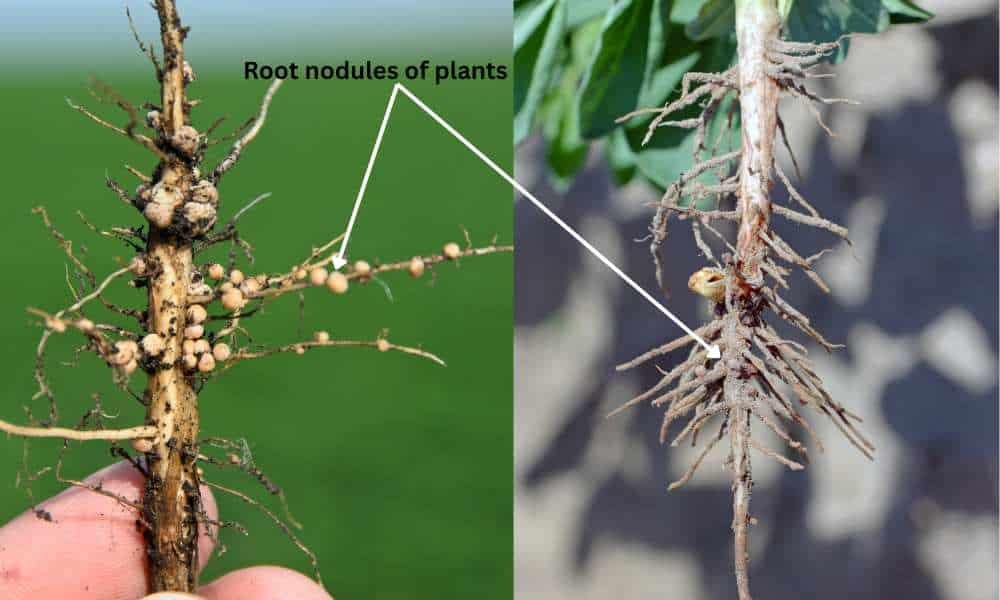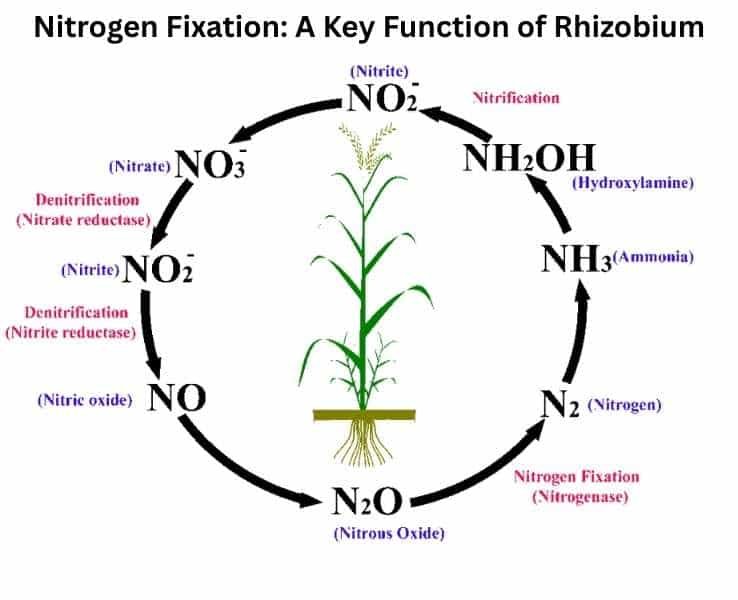Table of Contents
ToggleIntroduction
- Rhizobium is a remarkable bacterium known for its unique symbiotic relationship with the roots of leguminous plants.
- Found primarily in root nodules of plants like peas, beans, and lentils, Rhizobium plays a crucial role in biological nitrogen fixation.
- This process converts atmospheric nitrogen, which plants cannot directly use, into ammonia—a soluble form that plants can absorb.
- Ammonia serves as a vital nutrient, enhancing soil fertility and promoting plant growth, especially in nitrogen-deficient soils.
- In dry or nutrient-poor regions, Rhizobium is invaluable as a natural source of nitrogen.
Classification of Rhizobium Bacteria
Rhizobium belongs to the domain Bacteria and is classified as follows:
- Domain: Bacteria
- Phylum: Proteobacteria
- Class: Alphaproteobacteria
- Order: Rhizobiales
- Family: Rhizobiaceae
- Genus: Rhizobium
Some important species of Rhizobium include:
- Rhizobium leguminosarum
- Rhizobium alamii
- Rhizobium lantis
- Rhizobium japonicum
- Rhizobium trifolii
- Rhizobium phaseoli
- Rhizobium smilacinae
These species exhibit unique abilities to fix nitrogen in association with specific leguminous hosts.
Morphological Characteristics
Rhizobium bacteria are Gram-negative, rod-shaped organisms with a thin peptidoglycan layer that does not retain crystal violet during Gram staining. They are aerobic, requiring oxygen for growth and optimal nitrogen fixation. They thrive in slightly acidic to neutral pH conditions and are temperature-sensitive; extremely high temperatures can reduce their nitrogen-fixing efficiency.
- Gram staining: Negative
- Rod-shaped: They are rod-shaped in structure, like bacilli.
- Nitrogen fixation is the primary function of rhizobium, which takes nitrogen from the atmosphere and transforms it into ammonia.
- Symbiotic Relationship: Rhizobium has a symbiotic relationship with leguminous plants like peas, beans, and lentils. They invade the root hairs of these plants and form nodules, where nitrogen is stored.
- Temperature sensitivity: Rhizobium bacteria function best within a given temperature range. High temperatures may hinder their nitrogen-fixing capacity.
- pH sensitivity: They favor slightly acidic to neutral pH levels for optimal growth and nitrogen fixation. While some species can tolerate more alkaline or acidic environments.
- Aerobic: Rhizobium bacteria are aerobic, which means they need oxygen to live and develop.

Biochemical Tests of Rhizobium Bacteria
| Test Name | Result |
| Catalase test | Positive |
| Oxidase | Positive |
| Indole Production | Positive |
| Methyl Red | Positive |
| Hydrogen sulfide production test | Negative |
| Citrate utilization test | Positive |
| Urease test | Positive |
| Starch hydrolysis test | Positive |
| Voges Proskauer test | Positive |
Role of Rhizobium
Rhizobium is a flexible microorganism that has numerous effects on the environment, plants, animals, and other subjects. However, one of its most crucial functions is nitrogen fixation. This is essentially the conversion of atmospheric nitrogen into usable compounds.
Nitrogen Fixation: A Key Function of Rhizobium
- Nitrogen fixation is the biological process in which atmospheric nitrogen (N₂) is converted into ammonia (NH₃), a form that plants can assimilate.
- While nitrogen is abundant in the atmosphere, plants cannot utilize it directly. Rhizobium attaches to the roots of leguminous plants and forms specialized structures called root nodules, where nitrogen fixation occurs.
- The ammonia produced is absorbed by the plant and converted into essential biomolecules like proteins, nucleic acids, and other nitrogenous compounds.
- This process not only benefits the host plant but also enriches the soil with nitrogen, supporting subsequent crops and maintaining the global nitrogen cycle.

Symbiotic Relationship with Leguminous Plants
The relationship between Rhizobium and leguminous plants is mutually beneficial:
- For the plant: The bacterium provides a readily available source of nitrogen.
- For the bacterium: The plant supplies carbohydrates and a protected niche in root nodules.
Inside the root nodules, Rhizobium cells differentiate into bacteroids, which actively fix nitrogen. This natural symbiosis reduces the need for synthetic nitrogen fertilizers, making agriculture more sustainable.
Diseases Caused by Rhizobium Bacteria
Rhizobium can be either pathogenic or non-pathogenic. The pathogenic species of Rhizobium include:
- Rhizobium rhizogenic Also known as Agrobacterium rhizogenes, it induces infectious hairy roots in dicotyledonous plants.
- Rhizobium radiobacter, also known as Agrobacterium tumefaciens, induces crown gall disease.
These pathogenic species are studied extensively in plant pathology and genetic engineering, as they can transfer DNA into plant cells.

Benefits of Rhizobium
Agronomic Benefits of Rhizobium
Nitrogen Fixation: Rhizobium reduces the dependence on chemical fertilizers by naturally converting atmospheric nitrogen into plant-usable forms.
Improved Soil Fertility: The nitrogen-enriched soil supports future crops, enhancing soil productivity and sustainability.
Enhanced Crop Yields: By providing a steady nitrogen supply, Rhizobium boosts plant growth, yield, and quality.
Pest and Disease Resistance: Nitrogen-rich soils can promote healthier plants that are more resistant to pests and infections.
Environmental Benefits
- Reduced Fertilizer Runoff: Minimizes water pollution and eutrophication caused by synthetic fertilizers.
- Sustainability: Encourages organic farming practices by naturally enriching the soil.
- Soil Erosion Control: Healthy root systems stabilize soil, preventing erosion.
Economic Benefits
- Cost Savings: Farmers spend less on synthetic fertilizers while maintaining crop productivity.
- Long-Term Productivity: Enriched soil structure ensures sustained agricultural output over time.
Role of Rhizobium in Sustainable Agriculture
- Rhizobium is essential for sustainable agriculture since it naturally fixes atmospheric nitrogen in conjunction with leguminous plants, lowering the need for synthetic nitrogen fertilizers.
- This not only reduces farming costs, but also reduces environmental contamination caused by chemical fertilizers.
- Rhizobium boosts crop yield in an environmental friendly way by increasing soil fertility and supporting healthy plant development.
- Its application as a biofertilizer promotes organic farming practices, restores soil health, and contributes to long-term agricultural sustainability by preserving the natural nitrogen cycle and reducing reliance on non-renewable inputs.
Practical Applications of Rhizobium in Agriculture
- Biofertilizers: Commercial inoculants containing Rhizobium are applied to seeds or soil to improve legume growth.
- Soil Enrichment: Continuous use of Rhizobium-enriched crops maintains soil nitrogen content for future planting.
- Crop Rotation: Planting legumes with Rhizobium nodules improves nitrogen content for subsequent cereal crops.
- Research & Biotechnology: Pathogenic Rhizobium species are used as vectors in plant genetic engineering for crop improvement.
Conclusion
Rhizobium is far more than just a soil bacterium—it is a natural fertilizer factory, an eco-friendly agricultural partner, and a key player in the nitrogen cycle. Its ability to fix nitrogen symbiotically with legumes reduces the need for chemical fertilizers, improves crop yield, and supports sustainable farming practices worldwide.
Beyond agriculture, certain pathogenic species of Rhizobium have critical applications in plant biotechnology and genetic engineering.
In short, Rhizobium embodies the perfect balance between environmental sustainability, economic efficiency, and agricultural productivity.
Frequently Asked Questions (FAQ) About Rhizobium
Q1. What is Rhizobium?
Rhizobium is a genus of Gram-negative, rod-shaped bacteria that form a symbiotic relationship with the roots of leguminous plants. They live inside root nodules and are responsible for fixing atmospheric nitrogen into a usable form (ammonia) for plants.
Q2. Where is Rhizobium found?
Rhizobium is commonly found in the soil, particularly in association with the roots of legume plants such as beans, peas, lentils, and clover. Inside the root nodules, they perform biological nitrogen fixation.
Q3. Is Rhizobium Gram-positive or Gram-negative?
Rhizobium is Gram-negative because it has a thin peptidoglycan layer that does not retain crystal violet dye during Gram staining.
Q4. How does Rhizobium fix nitrogen?
Rhizobium converts atmospheric nitrogen (N₂) into ammonia (NH₃) through an enzymatic process using nitrogenase. This ammonia is then utilized by plants to produce proteins and other nitrogen-containing compounds.
Q5. What is the role of Rhizobium in agriculture?
Rhizobium improves soil fertility, enhances crop yields, and reduces the need for chemical nitrogen fertilizers. It plays a vital role in sustainable farming by supporting organic and eco-friendly cultivation practices.
Q6. Can Rhizobium grow without a host plant?
Rhizobium can survive freely in soil but cannot fix nitrogen without a host legume plant. Nitrogen fixation occurs only inside specialized root nodules.
Q7. Which plants benefit from Rhizobium?
Leguminous plants such as peas, beans, soybeans, clovers, alfalfa, and lentils benefit the most from Rhizobium inoculation.
Q8. Does Rhizobium cause any plant diseases?
While most Rhizobium species are beneficial, some related species are pathogenic, such as Rhizobium rhizogenes (causing hairy root disease) and Rhizobium radiobacter (causing crown gall disease).
Q9. What are the environmental benefits of Rhizobium?
Rhizobium reduces the use of synthetic fertilizers, prevents fertilizer runoff, enhances soil structure, and promotes biodiversity in agricultural systems.
Q10. How can farmers use Rhizobium as a biofertilizer?
Farmers can apply Rhizobium through seed coating, soil inoculation, or root dipping methods before planting legumes. This ensures early colonization of root hairs and effective nodule formation.
Also Read
- Bacillus subtilis– Morphology, Habitat, Diseases & Industrial Applications
- Basics of Food Microbiology in
- Top 10 Universities in India for Microbiology
- Immune System Cells: The Body’s Cellular Defenders
- Biochar: Properties, Production, and Applications
- Spirulina: The Superfood Microalga with Limitless Potential
- Microbiology: From Microorganisms to Career Opportunities
- Medical Microbiology Quiz
- Bacteriology Quiz
- Basic Microbiology Quiz
- Microbiology Notes

